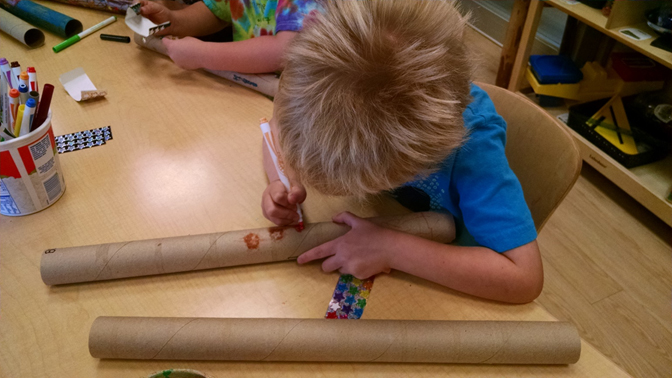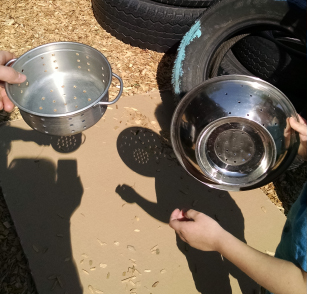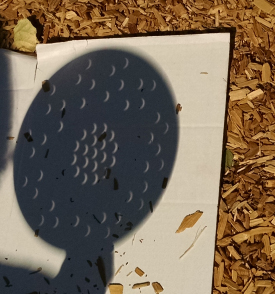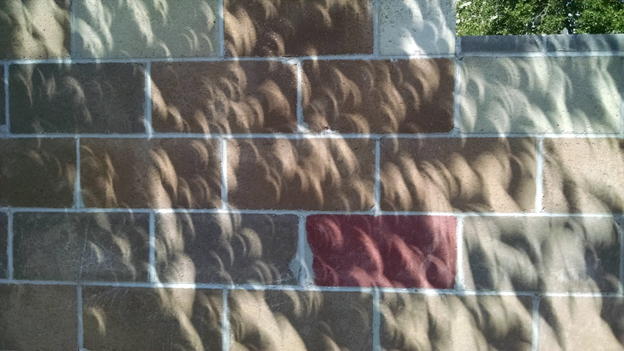Eclipse report from preschool
By Peggy Ashbrook
Posted on 2017-08-30

A total solar eclipse is seen on Monday, August 21, 2017 above Madras, Oregon. (NASA/Aubrey Gemignani)
While some elementary, middle, and high schools required all students to remain indoors with window blinds drawn so no light could enter during the August 21 solar eclipse, other schools planned science experiences to safely view the solar eclipse and at least one district secured “eclipse glasses” for all students and staff and had over 90% of parents submit online permission slips. Indoor viewing included watching live streaming from NASA, now archived for later viewing. Some communities have cultural reasons for observing the solar eclipse by remaining indoors, not because they hold misconceptions about eclipses.
Guest blogger Anne Lowry teaches preschool in Reno, Nevada. She has been teaching for over twenty years, drawing on her undergraduate background in archeology and geology and her masters in early childhood education, to create a classroom full of inquiry.
Welcome Anne!
The August 2017 solar eclipse was a once in a life time event for many people in the continental United Sates. The challenge of this eclipse was to prepare my pre-K class in a manner relevant to them, for an event which could not be re-experienced, though it could be revisited. And I had just three school days to do it.
I live in Reno, Nevada, where we were predicted to have 83% coverage. Though children in northern Nevada, which has high UV and many sunny days, are taught early on about the dangers of looking directly at the sun, we decided to focus on the viewing the eclipse indirectly. This shifted the attention away from looking directly at the sun, but rather observing the effects of the light. My preschool decided that make our own indirect projectors, though we did have a pair of solar viewing glasses available for teachers to use with students one on one (few children chose this option). Being aware of different cultural responses to the sun, as well as safety concerns, we offered our families a chance to “opt-out” of their child taking part in the actual eclipse viewing. One family chose this option. We also had several parents who stayed to watch the eclipse with their child.
 My pre-K students were aware of the eclipse and took part in many class activities in preparation. They learned an eclipse song* to introduce the basic mechanics of the moon, earth, and sun; it is still a class favorite! The class spent a lot of time decorating, then practicing, with their backs to the sun, holding the tubes over their shoulder and aimed at the ground where the image of the sun would be projected. My students worked together with flashlights as they created and played with models, assigning responsibilities, saying “You be the sun and hold the flashlight here. I’ll be the moon and move between the earth and sun.” Still using flashlights, the students created shadows from various objects and watched how the shadows changed with the flashlight angle. The students discussed the differences between night and day, focusing on comparative pairs.
My pre-K students were aware of the eclipse and took part in many class activities in preparation. They learned an eclipse song* to introduce the basic mechanics of the moon, earth, and sun; it is still a class favorite! The class spent a lot of time decorating, then practicing, with their backs to the sun, holding the tubes over their shoulder and aimed at the ground where the image of the sun would be projected. My students worked together with flashlights as they created and played with models, assigning responsibilities, saying “You be the sun and hold the flashlight here. I’ll be the moon and move between the earth and sun.” Still using flashlights, the students created shadows from various objects and watched how the shadows changed with the flashlight angle. The students discussed the differences between night and day, focusing on comparative pairs.
My class was curious about the percentage of sun being covered by the moon. 83% is a complex concept for preschoolers. We covered up 83% of a flashlight opening but drawing on graph paper made the concept more understandable. We practiced counting to ten horizontally and vertically, and then counted by 10’s to 100, pretending that was the entire surface of the sun Then we counted to eighty, marking off the graph paper, and added the three, showing how much of the moon would block the sun.
During our eclipse preparations the children were reminded about eclipse safety through two approaches. In the first, we discussed that scientists use their tools correctly. The second was a reminder as to how we stay sun safe every day.
On Monday morning, as the eclipse was just starting, the class reviewed their predictions:
“We will see lots of stars”
“I bet we are going to hear crickets”
“It’s going to be too light to see owls”
“We might hear coyotes”
“We might run into each other on the playground, it would be so dark. That would be silly!”
The class followed their regular morning schedule, going outside a little before 10 rather than the usual 10:30. Through the north-facing classroom windows, the students watched, commenting that they could see the shadows better, but the sky wasn’t getting any darker. The students had a special challenge that day; they could take classroom objects outside to see what kind of eclipse shadows would be made. The students aimed for objects with holes, such as colanders from the class home center (and my cheese grater from home).
The students repeated those comments when we went outside. They tried their tube viewers, pointing them at the ground to view an image of the sun, and paper pinhole viewers also aimed at the ground, but found the various colander shadows to be much more dramatic. The shape of the sun’s image seen in the colander shadows drew their attention to other places the sun’s image was visible in shadows on the playground, beginning a crescent shaped scavenger hunt.
The class reflected upon the experience over the next several days.
- The sky didn’t darken much more than it does in late afternoon.
- We didn’t hear crickets, owls or coyotes like we usually do during night time.
- Our school bunny seemed to be more interested in the fresh carrots than the occurrence of the eclipse.
- No one heard the baby quail or the grown up quail which had been seen on the previous Friday (perhaps they had been “followed” by children (chased) a bit too much that day).
One specific phenomenon continued to puzzle my students. Looking at the 83% totality graphic, they had predicted that the sky would get very dark, but the sky barely darkened at all. One child’s face lit up as he thought it through and explained it to his classmates.
“It didn’t get dark because it wasn’t the whole sun. The sun wasn’t wearing sunglasses. The sun didn’t get dark like the sky. The light was just being squeezed to one side like when I put my finger on the hose!”
Heads nodded. That made sense. But then another boy came up with a new question,
”When we do that in the garden (meaning the finger on the hose) the water goes faster. Did the light go faster?”
We are still working on how to answer that one. I’m arguing for writing to an astronomer; the students are working on framing their question as a search engine question.
 But this question highlights what my students gained from the eclipse. They now view themselves as scientists. They researched a topic, asked questions, gathered information, and reviewed their questions and asked new ones. These new questions are serving as a springboard for additional explorations. Through discussions large and small, and as individuals, we have worked all of our questions back to a central idea: exploring light, especially how light affects objects. One child is investigating why a flashlight beam shone through cardboard tubes looks dimmer when he attaches more tubes together. Next week, he wants to add “shiny stuff” to the insides because “shiny things make the light bounce into my eyes. It will bounce in the tube and be longer”.
But this question highlights what my students gained from the eclipse. They now view themselves as scientists. They researched a topic, asked questions, gathered information, and reviewed their questions and asked new ones. These new questions are serving as a springboard for additional explorations. Through discussions large and small, and as individuals, we have worked all of our questions back to a central idea: exploring light, especially how light affects objects. One child is investigating why a flashlight beam shone through cardboard tubes looks dimmer when he attaches more tubes together. Next week, he wants to add “shiny stuff” to the insides because “shiny things make the light bounce into my eyes. It will bounce in the tube and be longer”.
 Several students are intrigued by the concepts of opaqueness and translucence. One child has been taking the flashlights around the room, seeing which objects are opaque and translucent. He said he wants to make a ruler (meaning a scale) of the translucent objects, from “I can’t see my hand
Several students are intrigued by the concepts of opaqueness and translucence. One child has been taking the flashlights around the room, seeing which objects are opaque and translucent. He said he wants to make a ruler (meaning a scale) of the translucent objects, from “I can’t see my hand  through it” to “I see the flashlight through it.” Another child wants to find out how objects use the sunlight without getting burned. She thinks color will be important because “plants make food from the sun and plants are green.” Other children are observing how light reflects off surfaces.
through it” to “I see the flashlight through it.” Another child wants to find out how objects use the sunlight without getting burned. She thinks color will be important because “plants make food from the sun and plants are green.” Other children are observing how light reflects off surfaces.
Using the eclipse as a springboard, my students have become scientists. They are developing the habit of curiosity, which is highly valued in our class which has as one of the precepts, “Did you ask a good question today?”
*Eclipse Song
(To the tune of “Nighttime Animals” by colleague Jen Healey)
When the moon comes between the earth and sun
a solar eclipse has begun
It’s going to take a while; it starts to get dark
Baily’s beads are bright like a spark
Then the sun comes out on other side
Takes some time as the moon’s so wide
When the moon comes between the earth and sun
a solar eclipse has begun
(Alternative ending)
When the moon moves away from the earth and sun
a solar eclipse is now done
Disclaimer: The views expressed in this blog post are those of the author(s) and do not necessarily reflect the official position of the National Science Teaching Association (NSTA).







